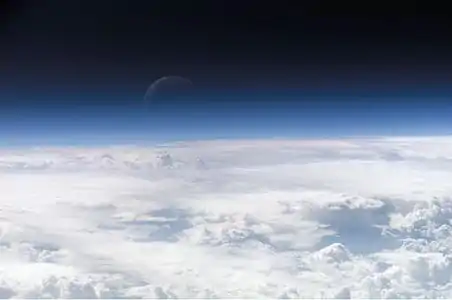Dione (moon)
Dione (/daɪˈoʊni/) is a moon of Saturn. It was discovered by Italian astronomer Giovanni Domenico Cassini in 1684.[10] It is named after the Titaness Dione of Greek mythology. It is also designated Saturn IV.
.jpg.webp) Dione photographed in natural light by the Cassini spacecraft in 2008 | |
| Discovery | |
|---|---|
| Discovered by | Giovanni Cassini |
| Discovery date | March 30, 1684 |
| Designations | |
Designation | Saturn IV |
| Pronunciation | /daɪˈoʊniː/[1] |
Named after | Διώνη Diōnē |
| Adjectives | Dionean[2] /daɪəˈniːən/[3] |
| Orbital characteristics | |
| 377396 km | |
| Eccentricity | 0.0022[4] |
| 2.736915 d[4] | |
| Inclination | 0.019° (to Saturn's equator) |
| Satellite of | Saturn |
| Physical characteristics | |
| Dimensions | 1128.8 × 1122.6 × 1119.2 km[5] |
Mean diameter | 1122.8±0.8 km[5] |
Mean radius | 561.4±0.4 km |
Surface area | 3964776.51 km2[6] |
| Mass | (1.095452±0.000168)×1021 kg[7] (1.834×10−4 Earths) |
Mean density | 1.478±0.003 g/cm3[5] |
Surface gravity | 0.232 m/s2 |
| 0.51 km/s | |
Synodic rotation period | 2.736915 d (synchronous) |
| zero | |
| Albedo | 0.998±0.004 (geometric)[8] |
| Temperature | 87 K (−186°C) |
| 10.4 [9] | |
Name
Giovanni Domenico Cassini named the four moons he discovered (Tethys, Dione, Rhea and Iapetus) Sidera Lodoicea ("the stars of Louis") to honor king Louis XIV. Cassini found Dione in 1684 using a large aerial telescope he set up on the grounds of the Paris Observatory.[11] The satellites of Saturn were not named until 1847, when William Herschel's son John Herschel published Results of Astronomical Observations made at the Cape of Good Hope, suggesting that the names of the Titans (sisters and brothers of Cronus) be used.[12]
Orbit
Dione orbits Saturn with a semimajor axis about 2% less than that of the Moon. However, reflecting Saturn's greater mass (95 times that of Earth), Dione's orbital period is one tenth that of the Moon. Dione is currently in a 1:2 mean-motion orbital resonance with moon Enceladus, completing one orbit of Saturn for every two orbits completed by Enceladus. This resonance maintains Enceladus's orbital eccentricity (0.0047), providing a source of heat for Enceladus's extensive geological activity, which shows up most dramatically in its cryovolcanic geyser-like jets.[13] The resonance also maintains a smaller eccentricity in Dione's orbit (0.0022), tidally heating it as well.[14]

Polydeuces · Helene · Dione · Saturn
Dione has two co-orbital, or trojan, moons, Helene and Polydeuces. They are located within Dione's Lagrangian points L4 and L5, 60 degrees ahead of and behind Dione respectively. A leading co-orbital moon twelve degrees ahead of Helene was reported by Stephen P. Synnott in 1982.[15][16]
Physical characteristics and interior
At 1122 km (697 mi) in diameter, Dione is the 15th largest moon in the Solar System, and is more massive than all known moons smaller than itself combined.[17] It is also Saturn's fourth-largest moon. Based on its density, Dione’s interior is likely a combination of silicate rock and water ice in nearly equal parts by mass.[18]
Shape and gravity observations collected by Cassini suggest a roughly 400 km radius rocky core surrounded by a roughly 160 km envelope of H2O, mainly in the form of water ice, but with some models suggesting that the lowermost part of this layer could be in the form of an internal liquid salt water ocean (a situation similar to that of its orbital resonance partner, Enceladus).[18][19][20][21] Downward bending of the surface associated with the 1.5 km high ridge Janiculum Dorsa can most easily be explained by the presence of such an ocean.[22][23] Neither moon has a shape close to hydrostatic equilibrium; the deviations are maintained by isostasy. Dione's ice shell is thought to vary in thickness by less than 5%, with the thinnest areas at the poles, where tidal heating of the crust is greatest.[21]
Though somewhat smaller and denser, Dione is otherwise very similar to Rhea. They both have similar albedo features and varied terrain, and both have dissimilar leading and trailing hemispheres. Dione's leading hemisphere is heavily cratered and is uniformly bright. Its trailing hemisphere, however, contains an unusual and distinctive surface feature: a network of bright ice cliffs.
Scientists recognise Dionean geological features of the following types:
- Chasmata (chasms; long, deep, steep-sided depressions or canyons)
- Dorsa (ridges)
- Fossae (long narrow depressions)
- Craters
- Catenae (crater chains)
Ice cliffs (formerly 'wispy terrain')
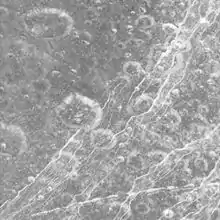
When the Voyager space probe photographed Dione in 1980, it showed what appeared to be wispy features covering its trailing hemisphere. The origin of these features was mysterious, because all that was known was that the material has a high albedo and is thin enough that it does not obscure the surface features underneath. One hypothesis was that shortly after its formation Dione was geologically active, and some process such as cryovolcanism resurfaced much of its surface, with the streaks forming from eruptions along cracks in the Dionean surface that fell back as snow or ash. Later, after the internal activity and resurfacing ceased, cratering continued primarily on the leading hemisphere and wiped out the streak patterns there.
This hypothesis was proven wrong by the Cassini probe flyby of December 13, 2004, which produced close-up images. These revealed that the 'wisps' were, in fact, not ice deposits at all, but rather bright ice cliffs created by tectonic fractures (chasmata). Dione has been revealed as a world riven by enormous fractures on its trailing hemisphere.
The Cassini orbiter performed a closer flyby of Dione at 500 km (310 mi) on October 11, 2005, and captured oblique images of the cliffs, showing that some of them are several hundred metres high.
Linear features
Dione features linear 'virgae' that are up to hundreds of km long but less than 5 km wide. These lines run parallel to the equator and are only apparent at lower latitudes (at less than 45° north or south); similar features are noted on Rhea. They are brighter than everything around them and appear to overlay other features such as ridges and craters, indicating they are relatively young. It has been proposed that these lines are of exogenic origin, as the result of the emplacement of material across the surface by low‐velocity impacts of material sourced from Saturn's rings, co‐orbital moons, or closely approaching comets.[24]
Craters
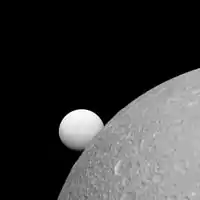
Dione's icy surface includes heavily cratered terrain, moderately cratered plains, lightly cratered plains, and areas of tectonic fractures. The heavily cratered terrain has numerous craters greater than 100 kilometres (62 mi) in diameter. The plains areas tend to have craters less than 30 kilometres (19 mi) in diameter. Some of the plains are more heavily cratered than others. Much of the heavily cratered terrain is located on the trailing hemisphere, with the less cratered plains areas present on the leading hemisphere. This is the opposite of what some scientists expected; Shoemaker and Wolfe[25] proposed a cratering model for a tidally locked satellite with the highest cratering rates on the leading hemisphere and the lowest on the trailing hemisphere. This suggests that during the period of heavy bombardment, Dione was tidally locked to Saturn in the opposite orientation. Because Dione is relatively small, an impact causing a 35 kilometer crater could have spun the satellite. Because there are many craters larger than 35 kilometres (22 mi), Dione could have been repeatedly spun during its early heavy bombardment. The pattern of cratering since then and the bright albedo of the leading side suggests that Dione has remained in its current orientation for several billion years.
Like Callisto, Dione's craters lack the high-relief features seen on the Moon and Mercury; this is probably due to slumping of the weak icy crust over geologic time.
Atmosphere
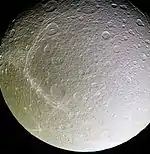
On April 7, 2010, instruments on board the unmanned Cassini probe, which flew by Dione, detected a thin layer of molecular oxygen ions (O+
2) around Dione, so thin that scientists prefer to call it an exosphere rather than a tenuous atmosphere.[26][27] The density of molecular oxygen ions determined from the Cassini plasma spectrometer data ranges from 0.01 to 0.09 per cm3.[27][28]
The Cassini probe instruments were unable to directly detect water from the exosphere due to high background levels,[27] but it seems that highly charged particles from the planet's powerful radiation belts could split the water in the ice into hydrogen and oxygen.[26]
Exploration
Dione was first imaged by the Voyager space probes. It has also been probed five times from close distances by the Cassini orbiter. There was a close targeted flyby, at a distance of 500 km (310 mi) on 11 October 2005;[29] another flyby was performed on 7 April 2010 also at a distance of 500 km.[30] A third flyby was performed on 12 December 2011 at a distance of 99 km (62 mi). The following flyby was on 16 June 2015 at a distance of 516 km (321 mi),[31] and the last Cassini flyby was performed on 17 August 2015 at a distance of 474 km (295 mi).[32][33]
In May 2013, it was announced that NASA's spacecraft Cassini had provided scientists with evidence that Dione is more active than previously realized. Using topographic data, NASA teams deduced that crustal depression associated with a prominent mountain ridge on the leading hemisphere is best explained if there was a global subsurface liquid ocean like that of Enceladus.[22][34][35] The ridge Janiculum Dorsa has a height of 1 to 2 km (0.6 to 1.2 miles); Dione's crust seems to pucker 0.5 km (0.3 miles) under it, suggesting that the icy crust was warm when the ridge formed, probably due to the presence of a subsurface liquid ocean, which increases tidal flexing.[36]
Gallery
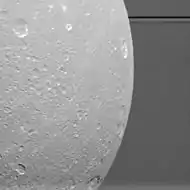
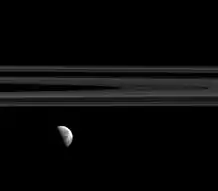
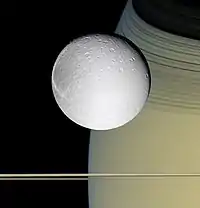

 Wispy terrain on Dione's trailing hemisphere. The Eurotas (top) and Palatine Chasmata run from upper right to lower left; the Padua Chasmata are near vertical at right, and the Carthage Fossae horizontal at left. The crater Cassandra and its ray system are at lower right.
Wispy terrain on Dione's trailing hemisphere. The Eurotas (top) and Palatine Chasmata run from upper right to lower left; the Padua Chasmata are near vertical at right, and the Carthage Fossae horizontal at left. The crater Cassandra and its ray system are at lower right.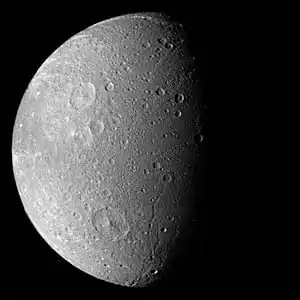 Dione as seen by Voyager 1; the craters prominent at upper and lower left are Dido and Aeneas; to the latter's right are the troughs Latium and Larissa chasmata.
Dione as seen by Voyager 1; the craters prominent at upper and lower left are Dido and Aeneas; to the latter's right are the troughs Latium and Larissa chasmata.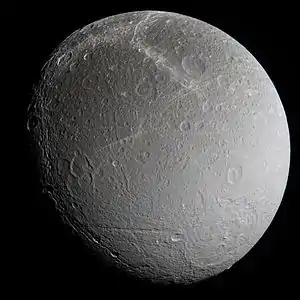 South polar features include huge, shallow impact basin Evander, the Palatine Chasmata by the terminator and Aufidus Catena between. The curving Padua Chasmata are at top.
South polar features include huge, shallow impact basin Evander, the Palatine Chasmata by the terminator and Aufidus Catena between. The curving Padua Chasmata are at top.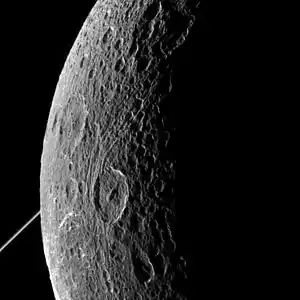 Dione in front of the rings of Saturn
Dione in front of the rings of Saturn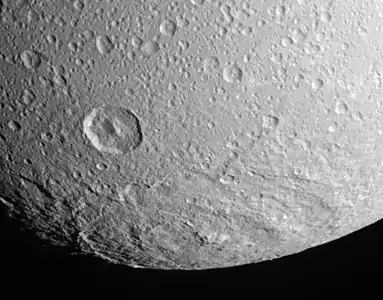 South polar impact basin Evander, 350 km in diameter, is by far the largest crater on Dione. The deep crater to its upper left is Sabinus.
South polar impact basin Evander, 350 km in diameter, is by far the largest crater on Dione. The deep crater to its upper left is Sabinus.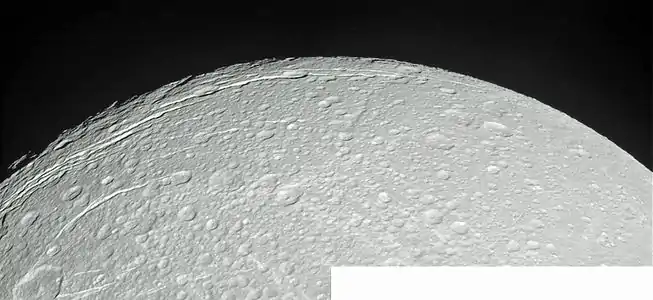 Panorama with fractures (the Palatine Chasmata) near limb, bisecting craters Euryalus (right) and Nisus just left of center. Crater Silvius is at lower left, with Himella Fossa to its upper right.
Panorama with fractures (the Palatine Chasmata) near limb, bisecting craters Euryalus (right) and Nisus just left of center. Crater Silvius is at lower left, with Himella Fossa to its upper right.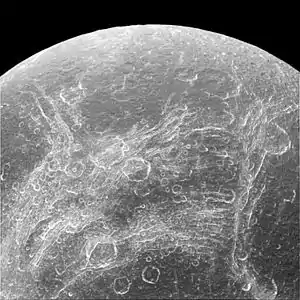 Chasms on Dione
Chasms on Dione
(trailing hemisphere; north is up)
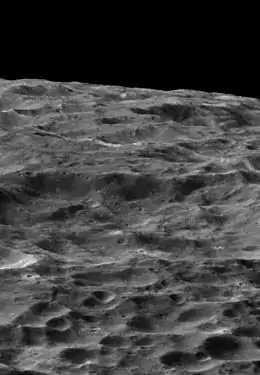 Close flyby of Dione reveals a highly cratered surface.
Close flyby of Dione reveals a highly cratered surface.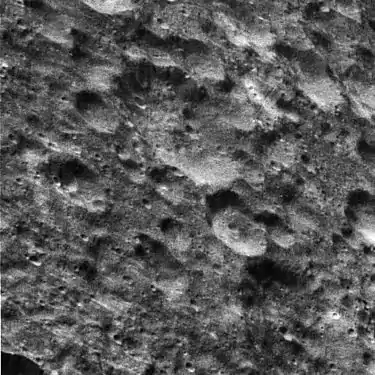 Nightside of Dione illuminated by Saturnshine.
Nightside of Dione illuminated by Saturnshine.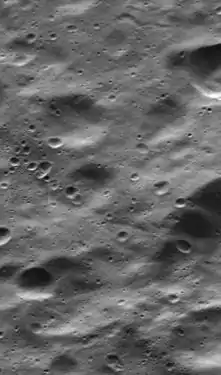 Close view of Dione
Close view of Dione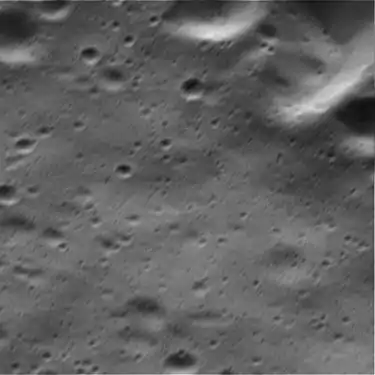 Closer view of part preceding image
Closer view of part preceding image
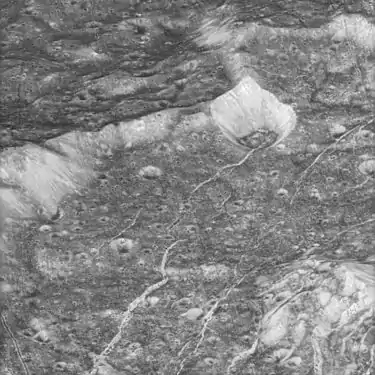 Differently sized and oriented fractures within 60-km crater Amastrus (central peak at lower right). Larger arcuate fractures running from lower left to upper right are the Padua Chasmata, whereas smaller more parallel fractures from lower right to upper left may be related to the Aurunca Chasmata.
Differently sized and oriented fractures within 60-km crater Amastrus (central peak at lower right). Larger arcuate fractures running from lower left to upper right are the Padua Chasmata, whereas smaller more parallel fractures from lower right to upper left may be related to the Aurunca Chasmata.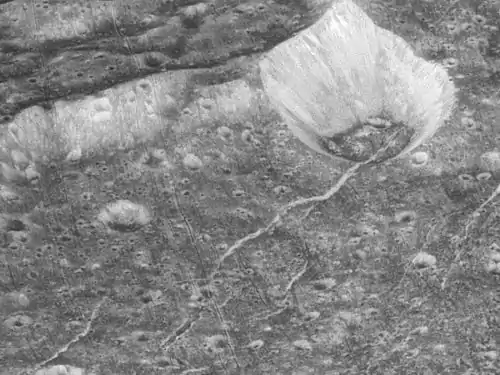 Crop of preceding image. The bowl-shaped crater at upper right has bright streaks on its walls, and dark material on its floor. To its lower left can be seen an arcuate fracture postdated (covered) by a small crater's ejecta, which in turn is postdated (incised) by parallel fractures.
Crop of preceding image. The bowl-shaped crater at upper right has bright streaks on its walls, and dark material on its floor. To its lower left can be seen an arcuate fracture postdated (covered) by a small crater's ejecta, which in turn is postdated (incised) by parallel fractures.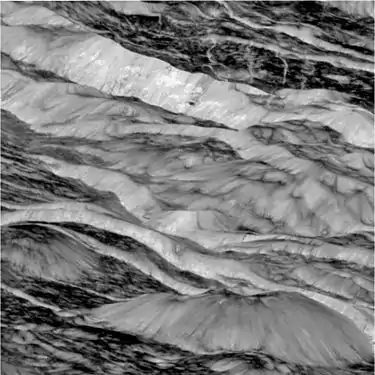 Oblique close-up of fractures
Oblique close-up of fractures
See also
- Dione in fiction
- Former classification of planets
- Helene – moon at Dione's leading Lagrangian point, L4
- Polydeuces – moon at Dione's trailing Lagrangian point, L5
References
- "Dione". Lexico UK English Dictionary. Oxford University Press. Archived from the original on March 22, 2020.
"Dione". Merriam-Webster Dictionary. - JPL (March 13, 2007) Cassini: Dionean Linea
- Len Krisak (2011) Virgil's Eclogues, p. 71
- "Data for our solar system". Exp.arc.nasa.gov. April 20, 2003. Archived from the original on 2005-03-09. Retrieved 2007-05-21.
- Roatsch, T.; Jaumann, R.; Stephan, K.; Thomas, P. C. (2009). "Cartographic Mapping of the Icy Satellites Using ISS and VIMS Data". Saturn from Cassini-Huygens. pp. 763–781. doi:10.1007/978-1-4020-9217-6_24. ISBN 978-1-4020-9216-9.
- Phil Davis? (April 1, 2011). "Solar System Exploration: Planets: Saturn: Moons: Dione: Facts & Figures". NASA. Archived from the original on October 12, 2012. Retrieved March 24, 2013.
- Jacobson, R. A.; Antreasian, P. G.; Bordi, J. J.; Criddle, K. E.; Ionasescu, R.; Jones, J. B.; Mackenzie, R. A.; Meek, M. C.; Parcher, D.; Pelletier, F. J.; Owen Jr., W. M.; Roth, D. C.; Roundhill, I. M.; Stauch, J. R. (December 2006). "The Gravity Field of the Saturnian System from Satellite Observations and Spacecraft Tracking Data". The Astronomical Journal. 132 (6): 2520–2526. Bibcode:2006AJ....132.2520J. doi:10.1086/508812.
- Verbiscer, A.; French, R.; Showalter, M.; Helfenstein, P. (9 February 2007). "Enceladus: Cosmic Graffiti Artist Caught in the Act". Science. 315 (5813): 815. Bibcode:2007Sci...315..815V. doi:10.1126/science.1134681. PMID 17289992. S2CID 21932253. Retrieved 20 December 2011. (supporting online material, table S1)
- Observatorio ARVAL (April 15, 2007). "Classic Satellites of the Solar System". Observatorio ARVAL. Archived from the original on September 20, 2011. Retrieved 2011-12-17.
- Cassini, G. D. (1686–1692). "An Extract of the Journal Des Scavans. Of April 22 st. N. 1686. Giving an Account of Two New Satellites of Saturn, Discovered Lately by Mr. Cassini at the Royal Observatory at Paris". Philosophical Transactions of the Royal Society of London. 16 (179–191): 79–85. Bibcode:1686RSPT...16...79C. doi:10.1098/rstl.1686.0013. JSTOR 101844.
- Fred W. Price (2000). The Planet Observer's Handbook. Cambridge University Press. p. 279. ISBN 978-0-521-78981-3.
- As reported by William Lassell, Monthly Notices of the Royal Astronomical Society, Vol. 8, No. 3, pp. 42–43 (January 14, 1848)
- Porco, C. C.; Helfenstein, P.; Thomas, P. C.; Ingersoll, A. P.; Wisdom, J.; West, R.; Neukum, G.; Denk, T.; Wagner, R. (10 March 2006). "Cassini Observes the Active South Pole of Enceladus" (PDF). Science. 311 (5766): 1393–1401. Bibcode:2006Sci...311.1393P. doi:10.1126/science.1123013. PMID 16527964. S2CID 6976648.
- Jia-Rui Cook (May 29, 2013). "Cassini Finds Hints of Activity at Saturn Moon Dione". NASA. Retrieved October 1, 2013.
- "IAUC 6162: Poss. Sats OF SATURN; AL Com".
- Guinness Book of Astronomy, Patrick Moore, Guinness Publishing, second edition, 1983 pp 110, 114
- See note g Triton (moon)#Notes
- Zannoni, M.; Hemingway, D. J.; Gomez Casajus, L.; Tortora, P. (15 July 2020). "The gravity field and interior structure of Dione". Icarus. 345 (1): 113713. arXiv:1908.07284. Bibcode:2020Icar..34513713Z. doi:10.1016/j.icarus.2020.113713. S2CID 201103604.
- "NASA Astrobiology Strategy" (PDF). NASA. 2015. Archived from the original (PDF) on 2016-12-22. Retrieved 2017-09-26.
- Howell, E. (2016-10-05). "Another Saturn Moon May Hide Subsurface Ocean". Seeker.com. Discovery Communications, LLC. Retrieved 2016-10-08.
- Beuthe, M.l; Rivoldini, A.; Trinh, A. (2016-09-28). "Enceladus' and Dione's floating ice shells supported by minimum stress isostasy". Geophysical Research Letters. 43 (19): 10, 088–10, 096. arXiv:1610.00548. Bibcode:2016GeoRL..4310088B. doi:10.1002/2016GL070650. S2CID 119236092.
- Hammond, N. P.; Phillips, C. B.; Nimmo, F.; Kattenhorn, S. A. (March 2013). "Flexure on Dione: Investigating subsurface structure and thermal history". Icarus. 223 (1): 418–422. Bibcode:2013Icar..223..418H. doi:10.1016/j.icarus.2012.12.021.
- Overlooked Ocean Worlds Fill the Outer Solar System. John Wenz, Scientific American. 4 October 2017.
- Martin, E. S.; Patthoff, D. A. (2018). "Mysterious Linear Features Across Saturn's Moon Dione". Geophysical Research Letters. 45 (20): 10, 978–10, 986. Bibcode:2018GeoRL..4510978M. doi:10.1029/2018GL079819. ISSN 1944-8007.
- Shoemaker, E. M.; and Wolfe, R. F.; Cratering time scales for the Galilean satellites, in Morrison, D., editor; Satellites of Jupiter, University of Arizona Press, Tucson (AZ) (1982), pp. 277–339
- Ghosh, Pallab (2 March 2012). "Oxygen envelops Saturn's icy moon". BBC News. Retrieved 2012-03-02.
- Robert L. Tokar; Robert E. Johnson; Michelle F. Thomsen; Edward C. Sittler; Andrew J. Coates; et al. (10 January 2012). "Detection of Exospheric O2+ at Saturn's Moon Dione". Geophysical Research Letters. 39 (3): n/a. Bibcode:2012GeoRL..39.3105T. doi:10.1029/2011GL050452.
- Sven Simon; Joachim Saur; itz M. Neubauer; Alexandre Wennmacher; Michele K. Dougherty (2011). "Magnetic signatures of a tenuous atmosphere at Dione". Geophysical Research Letters. 38 (L15102): 5. Bibcode:2011GeoRL..3815102S. doi:10.1029/2011GL048454.
- Martinez, Carolina (2005-10-17). "Cassini Views Dione, a Frigid Ice World". NASA. Retrieved 22 August 2015.
- Cassini Doubleheader: Flying By Titan and Dione (April 2010). NASA – Cassini Solstice MIssion.
- Landau, Elizabeth; Dyches, Preston (17 June 2015). "Cassini Sends Back Views After Zooming Past Dione". Jet Propulsion Laboratory. Retrieved 2017-07-21.
- Dyches, Preston (August 13, 2015). "Cassini to Make Last Close Flyby of Saturn Moon Dione". NASA News. Retrieved 2015-08-19.
- Spacecraft Makes Final Close Flyby of Saturn Moon Dione Today. Space.com Calla Cofield. August 17, 2015.
- Collins, G. C. (2010). Collins, G. C. (ed.). Testing Candidate Driving Forces for Faulting on Dione: Implications for Nonsynchronous Rotation and a Freezing Ocean. American Geophysical Union, Fall Meeting 2010, abstract #P24A-08. AGU Fall Meeting Abstracts. Vol. 2010. pp. P24A–08. Bibcode:2010AGUFM.P24A..08C.
- Phillips, C. B.; Hammond, N. P.; Roberts, J. H.; Nimmo, F. (2012). Subsurface Structure and Thermal History of Icy Satellites from Stereo Topography. American Geophysical Union, Fall Meeting 2012, abstract #P22B-03. Bibcode:2012AGUFM.P22B..03P.
- "Cassini Finds Hints of Activity at Saturn Moon Dione". NASA News. 29 May 2013. Retrieved 2015-05-29.
External links
- Dione Profile at NASA's Solar System Exploration site
- The Planetary Society: Dione
- Cassini images of Dione Archived 2011-09-17 at the Wayback Machine
- Images of Dione at JPL's Planetary Photojournal
- 3D shape model of Dione (requires WebGL)
- Dione global Archived 2018-10-31 at the Wayback Machine and polar Archived 2018-10-31 at the Wayback Machine basemaps (December 2011) from Cassini images
- Dione atlas (Sept. 2011) from Cassini images Archived 2021-05-17 at the Wayback Machine
- Dione nomenclature and Dione map with feature names from the USGS planetary nomenclature page
- Google Dione 3D, interactive map of the moon
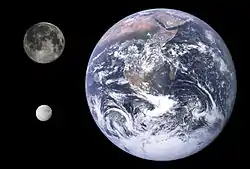
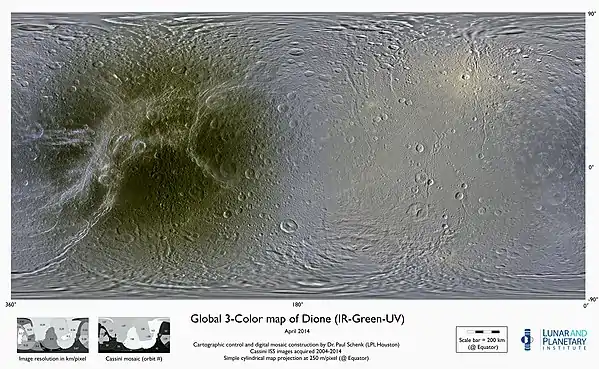
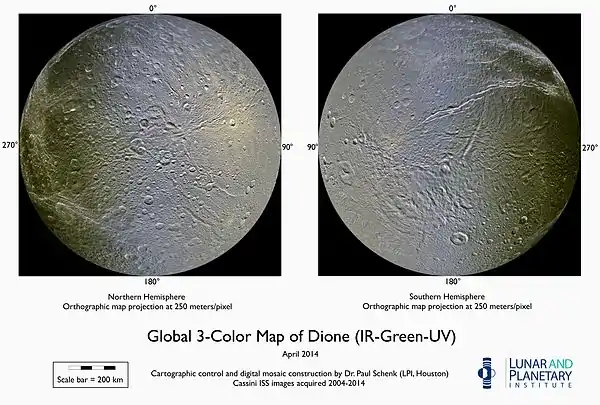
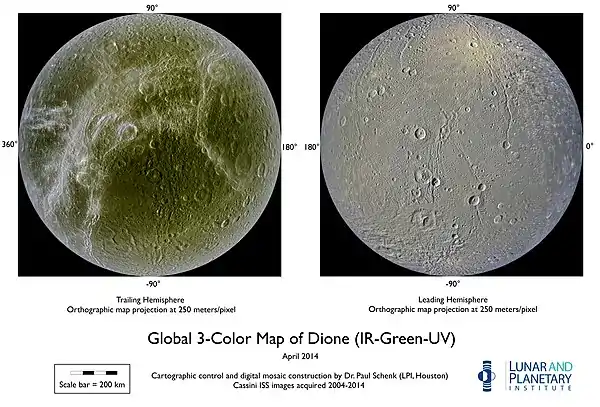


.jpg.webp)
